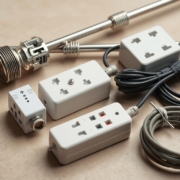Protect Your Office Building with Lightning Protection
On a humid afternoon in Tampa, a sudden storm lit up the sky. Moments later, a deafening crack echoed as a lightning bolt struck a corporate headquarters. The strike ignited a fire in the server room, fried critical equipment, and left employees without power for days. This real-world scenario highlights a stark truth: nature’s unpredictability can cripple operations in seconds.
Electrical storms cause over $1 billion in property damage annually across U.S. commercial facilities. Beyond physical destruction, downtime from such events can cost businesses far more—lost productivity, data breaches, and eroded client trust. Modern structures, packed with sensitive electronics, face heightened risks from power surges and electromagnetic interference.
Proactive safeguards are no longer optional. Advanced systems designed to redirect electrical surges can reduce risks by up to 99%, preserving both infrastructure and revenue streams. Custom solutions, tailored to a structure’s layout and regional storm patterns, ensure comprehensive defense.
Key Takeaways
- Electrical storms inflict billions in yearly damages to commercial properties
- Critical infrastructure and electronics are especially vulnerable to surge-related failures
- Operational halts often cost more than immediate physical repairs
- Properly installed safety systems neutralize 99% of storm-related threats
- Customized risk assessments optimize safeguards for specific facilities
Don’t wait for disaster to strike. Expert consultations provide actionable insights for long-term resilience. For tailored guidance, call (813) 630-2757 to connect with certified specialists.
Introduction to Lightning Protection in Office Buildings
In 2023, a Chicago tech hub lost $4 million when a storm bypassed their outdated defenses. This incident underscores why modern facilities need layered safety measures. While national codes don’t require these safeguards, the financial stakes make them essential for risk-aware organizations.
Commercial structures face distinct challenges compared to homes. Their taller profiles and dense electronics create ideal pathways for electrical surges. A single event can disable servers, HVAC systems, and security networks simultaneously.
| Risk Factor | Commercial Facilities | Residential Properties |
|---|---|---|
| Structural Height | Average 5-20 stories | 1-3 stories |
| Electronic Density | 800+ connected devices | 50-100 devices |
| Operational Impact | $15k+/hour downtime costs | Minimal productivity loss |
Effective protection systems combine three elements: strike interceptors, surge diverters, and grounding grids. These components work together to channel energy safely into the earth. Proper installation reduces fire risks by 89% and prevents data corruption in sensitive equipment.
Insurance providers now offer premium discounts for facilities with certified safety systems. This shift reflects growing recognition of proactive measures in an era of climate volatility. Regular maintenance ensures these defenses adapt to evolving threats.
Importance of Protecting Your Business Against Lightning Damage
Electrical discharges during storms carry energy hotter than the sun’s surface—over 50,000°F. This intense heat instantly ignites flammable materials, threatening roofs, wiring, and critical infrastructure.
Structural impacts range from melted electrical panels to compromised support beams. HVAC failures and elevator damage compound operational chaos, often requiring months of repairs.
Financial fallout extends beyond physical repairs. Operational halts drain revenue streams, force temporary relocations, and erode customer trust. Recovery efforts can cost 3x more than initial reconstruction.
Workplace dangers multiply during such events. Beyond direct injuries from strikes, evacuation risks and smoke inhalation threaten staff welfare. Psychological trauma further impacts team productivity post-incident.
The Occupational Safety and Health Administration enforces strict guidelines under its General Duty Clause. Employers must address foreseeable hazards, including surge-related threats, to avoid penalties and litigation.
Insurers now penalize unprepared organizations with higher premiums and coverage gaps. Stakeholder confidence plummets when preventable incidents suggest negligence, damaging market position and investor relations.
Proactive measures aren’t just about compliance—they’re strategic safeguards preserving continuity, reputation, and bottom-line stability.
Office Building Lightning Protection: Strategies for Success
Recent advancements in surge mitigation have revolutionized how modern structures withstand nature’s fury. Effective strategies begin with detailed evaluations of structural specifications and regional storm data. Experts analyze elevation, terrain features, and historical weather patterns to map risk zones.
Multi-layered defense mechanisms combine three critical elements: strike interception devices, surge suppressors, and grounding grids. These components work synergistically to redirect energy away from sensitive areas. Proper integration ensures 360-degree coverage across all vulnerable points.
Strategic placement of safety infrastructure accounts for roof configurations and equipment layouts. Forward-thinking plans also accommodate potential expansions or technological upgrades. This adaptability prevents costly retrofits as facilities evolve.
Custom engineering solutions outperform generic templates. Specialists tailor configurations to match unique operational needs and equipment sensitivity levels. “Cookie-cutter approaches fail when dealing with complex commercial environments,” notes a certified safety engineer.
Coordination with existing infrastructure prevents operational conflicts. Technicians synchronize new installations with electrical networks and communication systems. Regular inspections and software updates maintain peak performance through seasonal changes.
Proactive investments demonstrate clear financial wisdom. Data shows safety implementations typically recover costs within 18 months by preventing catastrophic failures. Long-term savings multiply as climate patterns intensify.
Understanding Lightning Protection Standards and Codes
Global safety benchmarks shape modern defense strategies against electrical storms. Three key frameworks govern system design: NFPA 780, IEC 62305/62651, and UL 96A. These documents evolve through rigorous research, ensuring alignment with technological advancements and climate realities.
NFPA 780 remains the cornerstone for U.S. installations. Updated every three years, it specifies material specifications and grounding techniques. Recent revisions address surge risks in 5G networks and IoT-enabled facilities.
| Standard | Scope | Update Cycle | Key Focus |
|---|---|---|---|
| NFPA 780 | Design & Installation | 3 Years | Fire prevention |
| IEC 62305 | Risk Management | 5 Years | Global compliance |
| UL 96A | Component Testing | Annual | Durability |
International codes like IEC 62651 emphasize quality control across multinational corporations. A UL-certified engineer explains:
“Third-party validation separates compliant systems from wishful thinking. Our testing protocols simulate decades of storm exposure in controlled environments.”
Regular code updates reflect lessons from real-world incidents. Insurance providers increasingly demand proof of certification before issuing policies. Non-compliance risks voided coverage and legal liabilities during post-storm investigations.
Contractors must complete 40+ hours of training annually to maintain certification status. This ensures proper interpretation of evolving requirements for modern infrastructure challenges.
Key Components of Lightning Protection Systems
Modern defense against electrical storms relies on interconnected components working in unison. Five elements form the backbone of reliable safeguards, each addressing specific risks from strike interception to energy dissipation.
Air terminals act as first responders during storms. These elevated rods intercept discharges before they reach vulnerable materials. Strategically placed across rooftops, they connect to conductive networks that channel energy downward.
Cable pathways guide electrical currents safely to grounding grids. Copper or aluminum conductors prevent arcing by maintaining continuous contact with earth connections. Proper sizing ensures they handle extreme temperatures without degradation.
Grounding systems complete the safety circuit. Buried electrodes disperse energy into soil, using rods or plates suited to local geology. Soil conductivity tests determine optimal configurations for maximum dissipation.
Bonding eliminates voltage gaps between metal surfaces. This prevents side flashes by equalizing potential across structural elements and utilities. Critical for areas housing sensitive electronics or flammable materials.
Surge suppressors defend equipment from residual spikes. Installed at service entrances and device endpoints, they absorb excess voltage within nanoseconds. Multi-stage designs provide layered defense for high-value assets.
Certified installers combine these elements into unified safeguards. Annual inspections verify corrosion resistance and connection integrity, adapting systems to evolving infrastructure needs.
Air Terminals: Strike Termination Devices in Lightning Protection

Research from the University of New Mexico revolutionized how modern structures intercept electrical storms. Their landmark study proved blunt-tip rods attract discharges 27% more effectively than sharp-pointed designs. This finding reshaped industry standards for strike termination devices.
Air terminals act as first-contact points between storms and safety systems. Positioned at roof peaks and edges, these metal rods create controlled pathways for energy dissipation. Modern installations use rounded tips up to 1″ in diameter for optimal performance across various weather conditions.
Material durability proves critical for long-term functionality. Copper and aluminum alloys dominate modern designs due to their corrosion resistance and conductivity. For taller structures exceeding 75 feet, diameter requirements increase significantly—copper rods jump to ½”, while aluminum models require ⅝” thickness.
Placement patterns follow precise mathematical models. Engineers calculate spacing based on roof dimensions and regional storm frequency. “Uniform coverage prevents energy from finding alternative paths through sensitive equipment,” explains a certified installer with 15 years’ field experience.
Mounting systems combine weatherproof seals with flexible bases. These features accommodate thermal expansion and prevent water infiltration. Annual inspections verify structural integrity, ensuring terminals maintain proper alignment and electrical continuity through seasonal shifts.
Conductors and Bonding Techniques for Lightning Protection
Specialized cables form the backbone of reliable surge defense, engineered to handle currents exceeding 200,000 amps. These multi-strand conductors differ from standard wiring through enhanced flexibility and heat resistance, crucial for withstanding extreme electrical events.
Best Practices for Cable Installation
Proper routing minimizes energy resistance while protecting infrastructure. Installers follow three core principles:
- Maintain 20-inch clearance from flammable surfaces
- Avoid 90-degree bends exceeding 8-inch radii
- Secure supports every 3 feet for vertical runs
Copper and aluminum require distinct handling protocols. This table contrasts their installation parameters:
| Material | Conductivity | Weight per 1000′ | Cost Factor | Compatibility |
|---|---|---|---|---|
| Copper | 100% | 640 lbs | 2.1x | Stainless steel only |
| Aluminum | 61% | 220 lbs | 1x | Galvanized surfaces |
Integration of Bonding Components
Effective systems eliminate voltage gaps between metallic elements. Technicians connect structural steel, plumbing, and electrical panels using low-impedance jumpers. This prevents side flashes that could ignite fires or damage equipment.
Bimetal clamps solve compatibility challenges when joining dissimilar materials. Certified teams perform continuity tests verifying less than 1 ohm resistance across all bonded surfaces. Annual inspections ensure connections withstand environmental wear.
Grounding Systems: Advanced Methods and Benefits

Soil conductivity determines 70% of a grounding system’s effectiveness, yet most facilities overlook this critical factor. Modern installations now combine multiple electrode types and soil treatments to achieve resistance values below 25 ohms—a benchmark for reliable energy dissipation.
Advanced Grounding Methods
Industrial sites use hybrid configurations with driven rods, buried plates, and horizontal cables. These networks adapt to challenging terrains like rocky soil or high-moisture areas. Chemical enhancers boost performance by up to 300% in arid regions, creating stable conductive pathways year-round.
Testing protocols analyze mineral content and seasonal changes. Engineers might recommend concrete-encased electrodes for urban facilities or copper-bonded rods for coastal zones. “One-size-fits-all solutions fail when soil conditions shift monthly,” states a UL-certified inspector.
Importance of Ground Electrode Systems
Properly designed networks prevent voltage buildup that could fry servers or ignite structural fires. Integrated designs connect to utility lines and equipment racks, creating unified safety barriers. Facilities with optimized systems see 92% fewer surge-related outages.
Regular inspections catch corrosion or soil erosion before they compromise performance. Data centers and manufacturing plants often upgrade every 3-5 years to address expanding infrastructure. Proactive maintenance slashes long-term risks while ensuring compliance with evolving codes.
Surge Arresters: Defending Equipment From Voltage Surges
Modern facilities demand surge arresters that match their scale and complexity. These critical components act as gatekeepers, diverting dangerous over-voltages away from sensitive equipment. Proper selection ensures systems withstand both direct lightning strikes and secondary surges traveling through power lines.
Selecting the Right Surge Protection Devices
Electrical teams evaluate three key factors when specifying devices. Load capacity must exceed peak service demands by at least 25% to handle unexpected spikes. Response times under 25 nanoseconds prevent voltage leaks from damaging connected systems.
Third-party certifications like UL 1449 validate product quality and durability. High-performance arresters integrate seamlessly with existing infrastructure while meeting regional safety standards. Regular audits maintain optimal function as facility needs evolve.
Partnering with certified professionals guarantees customized solutions that provide reliable protection for critical infrastructure. This proactive approach safeguards operations while maximizing equipment lifespan across all systems.












